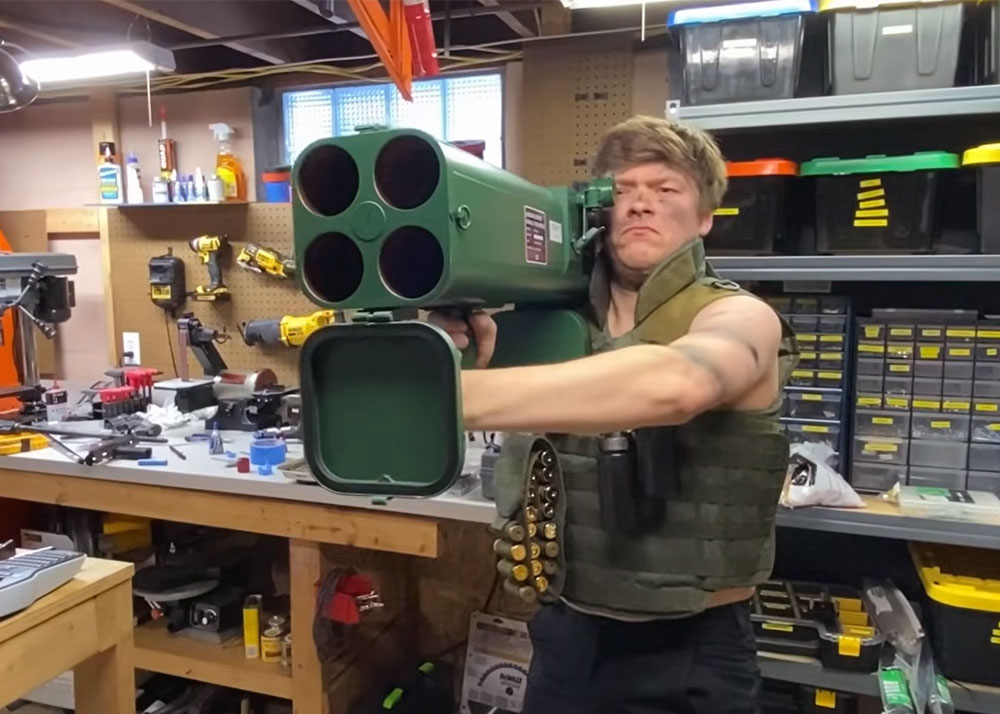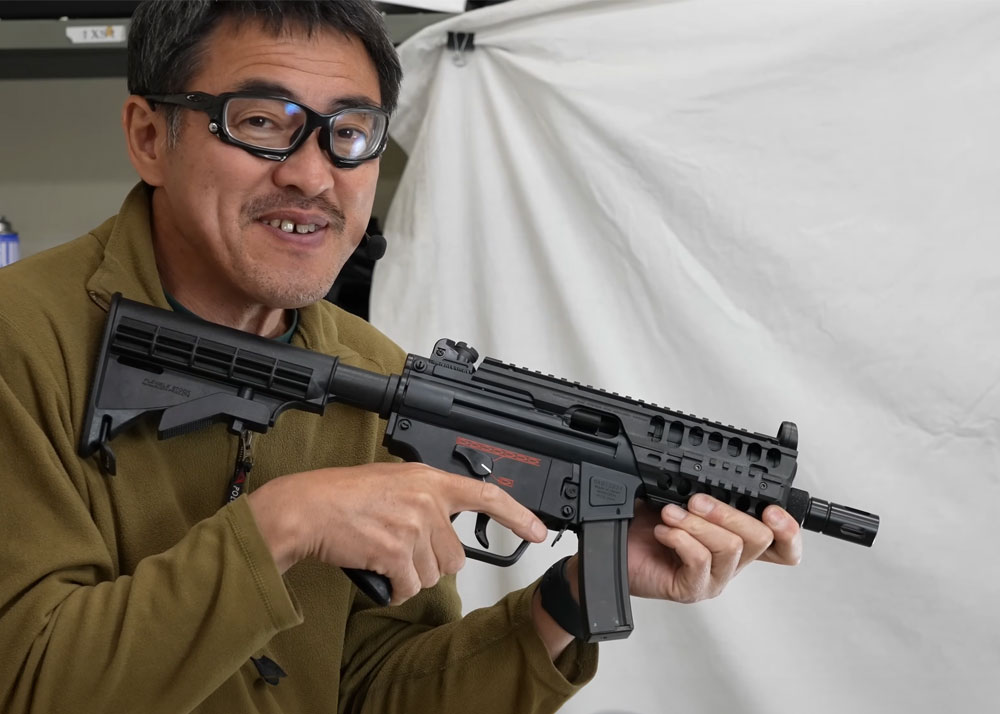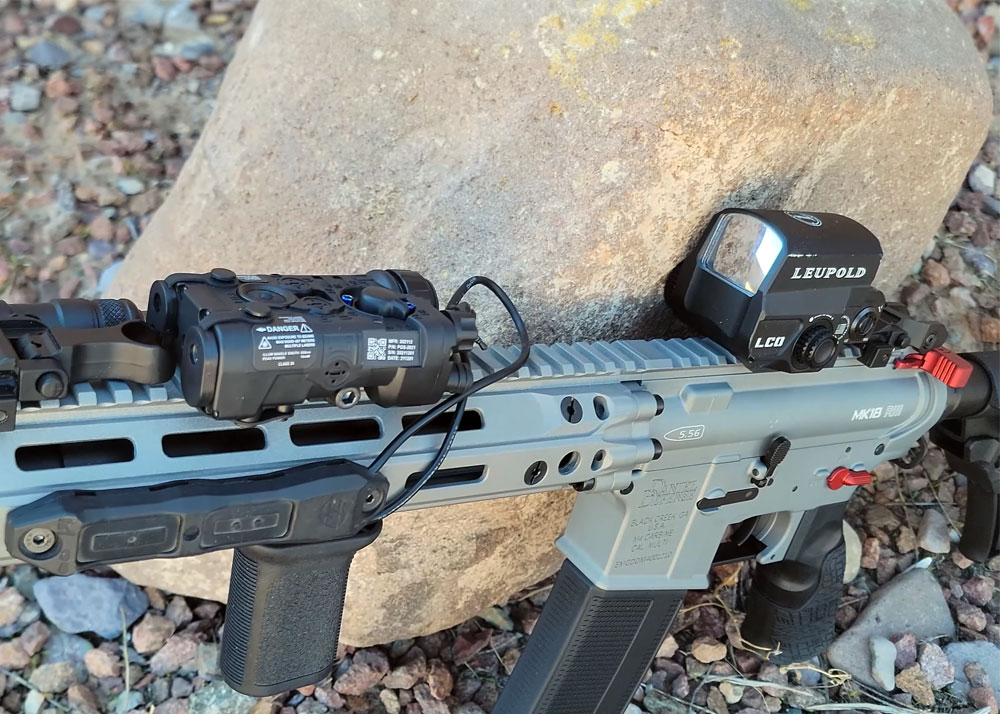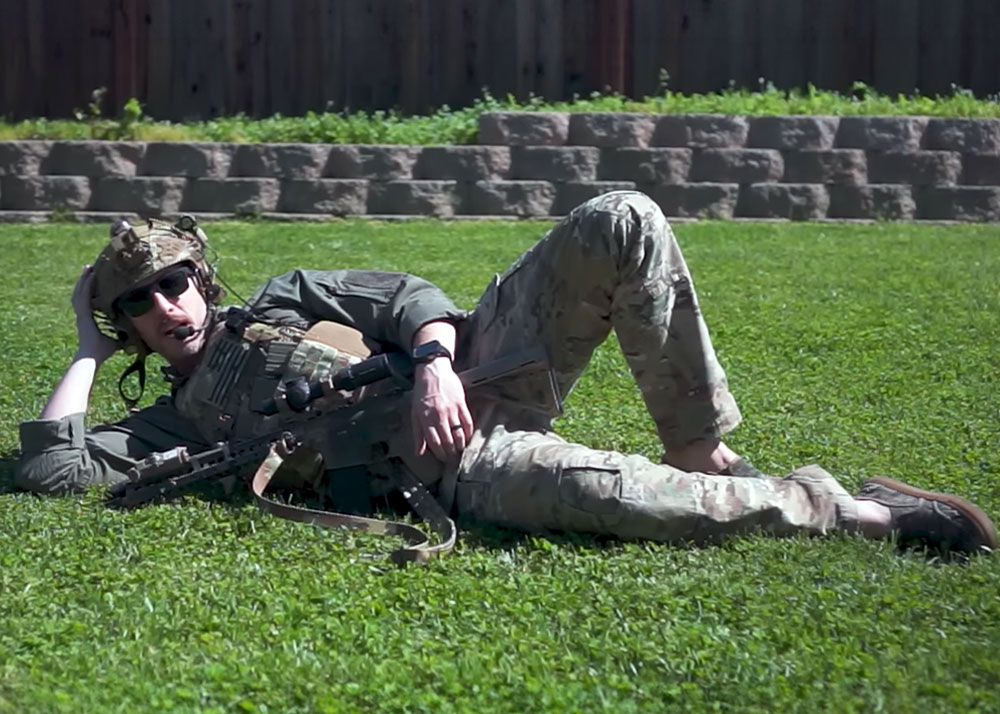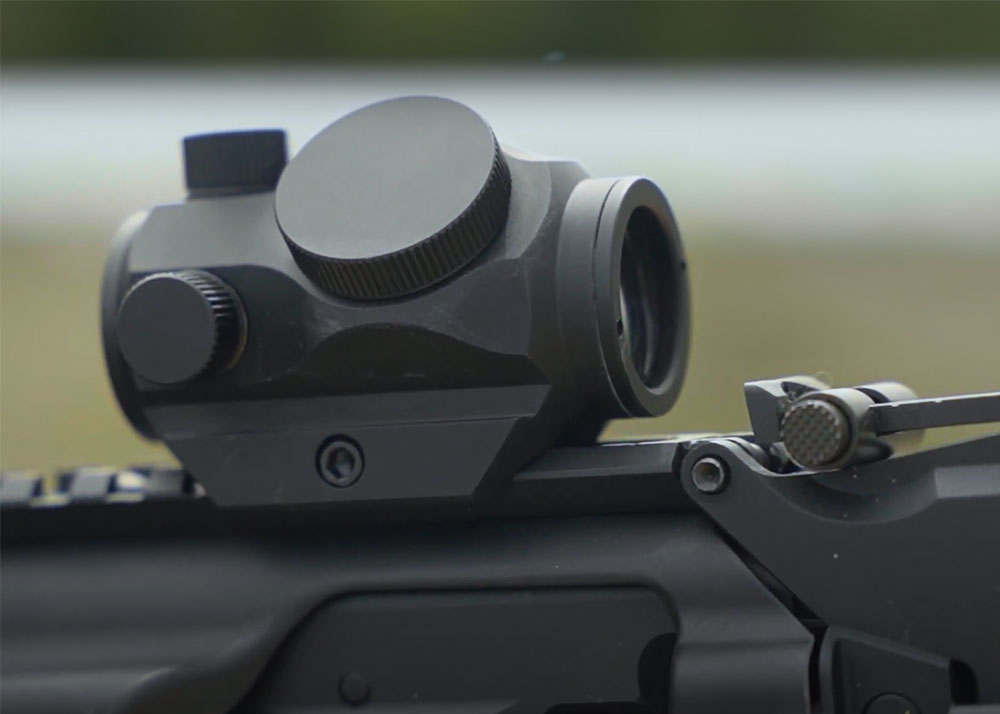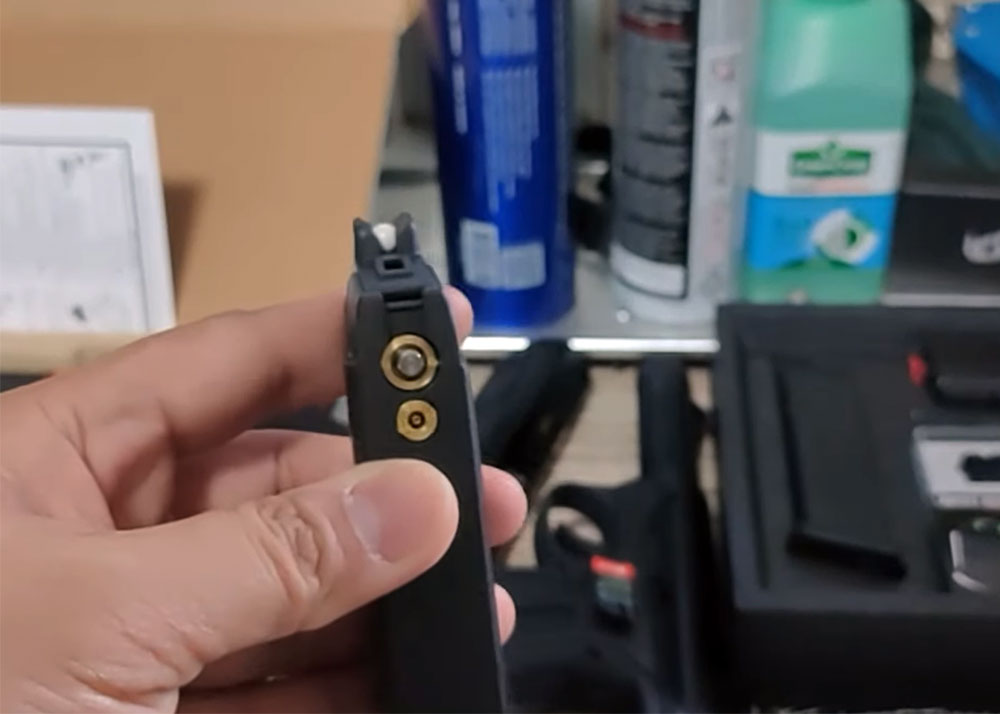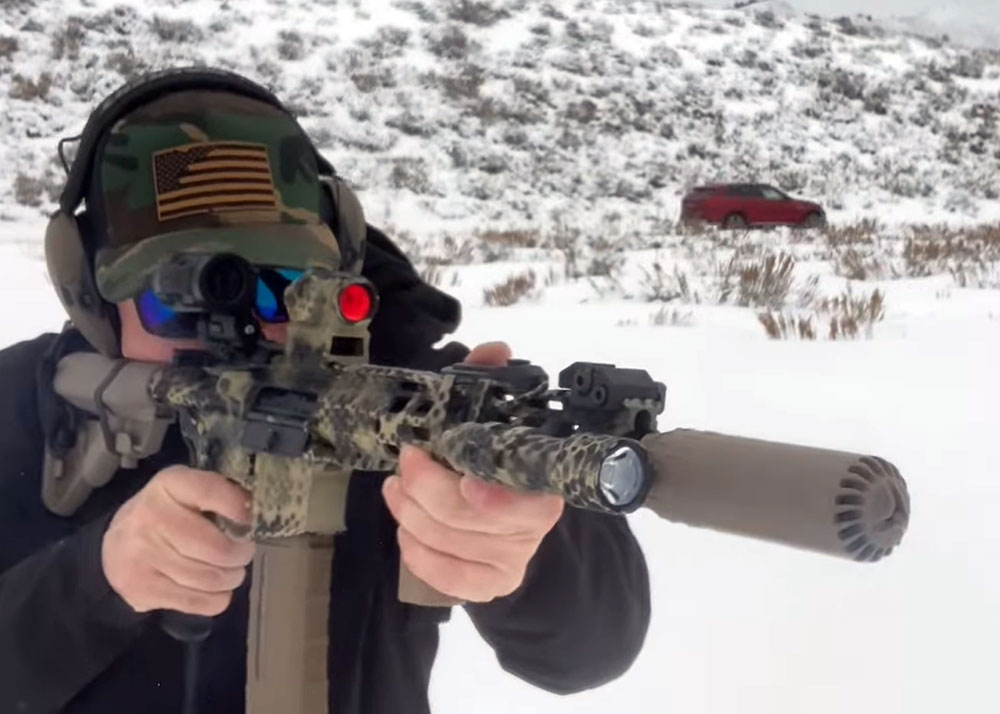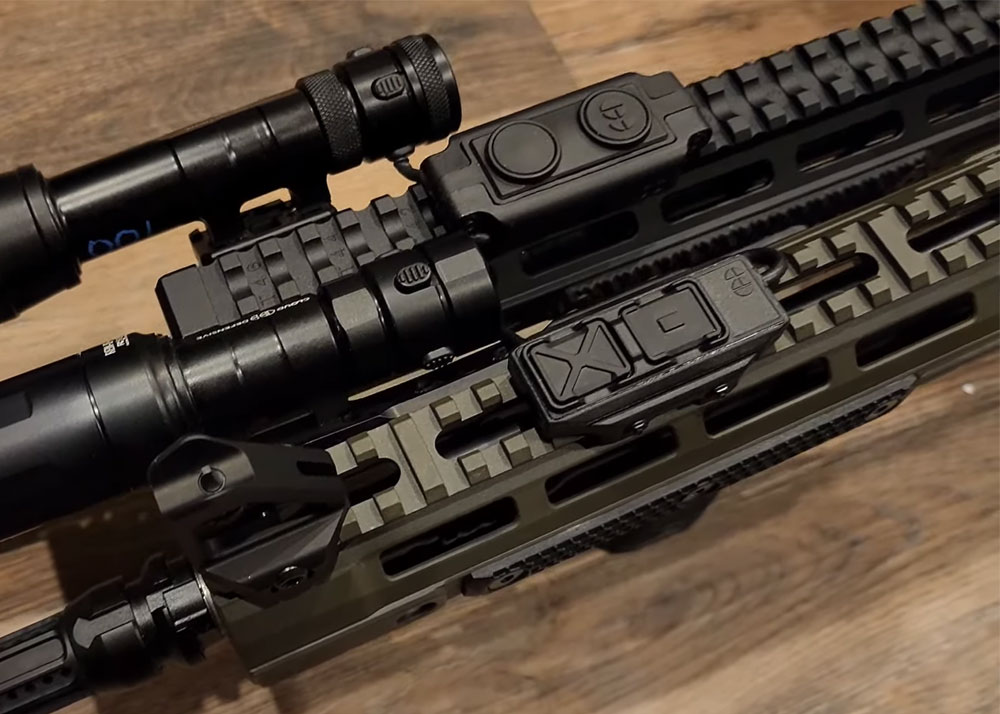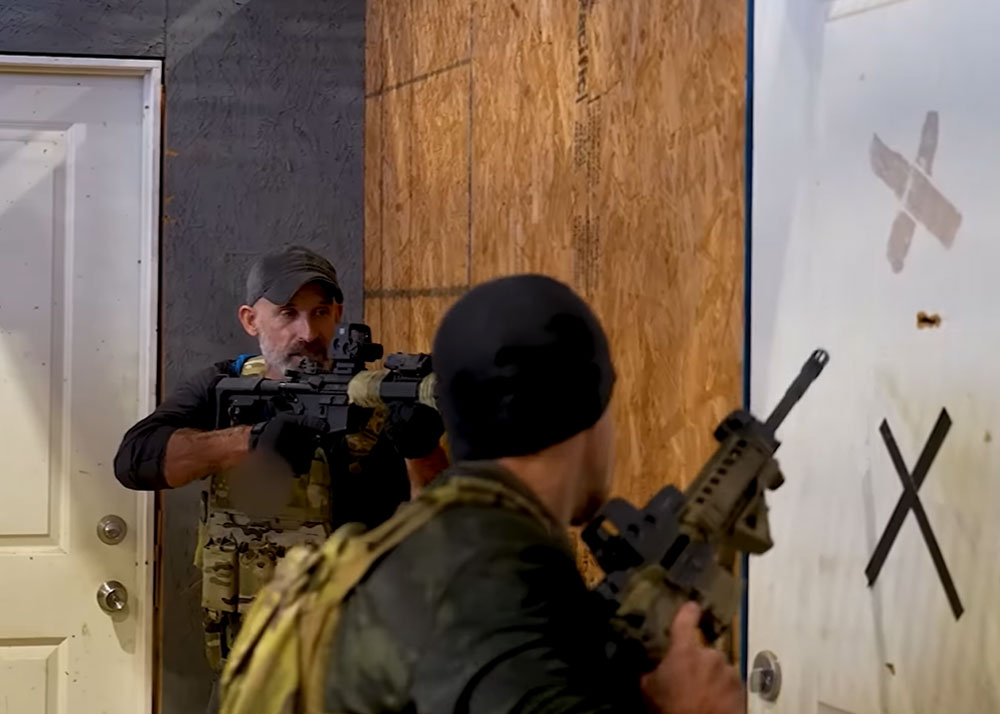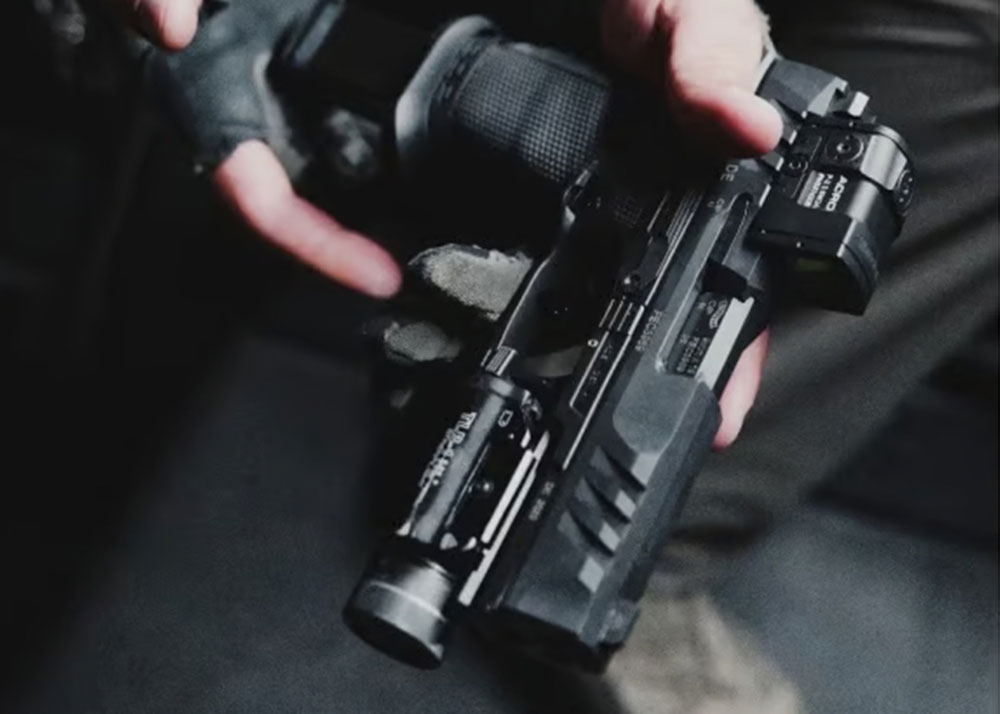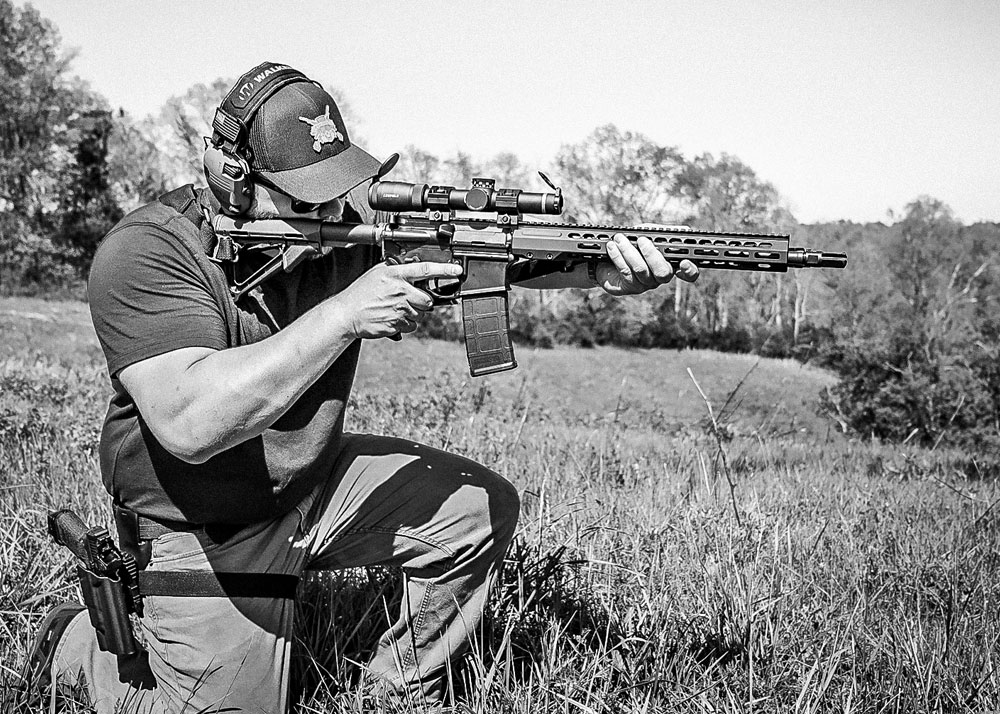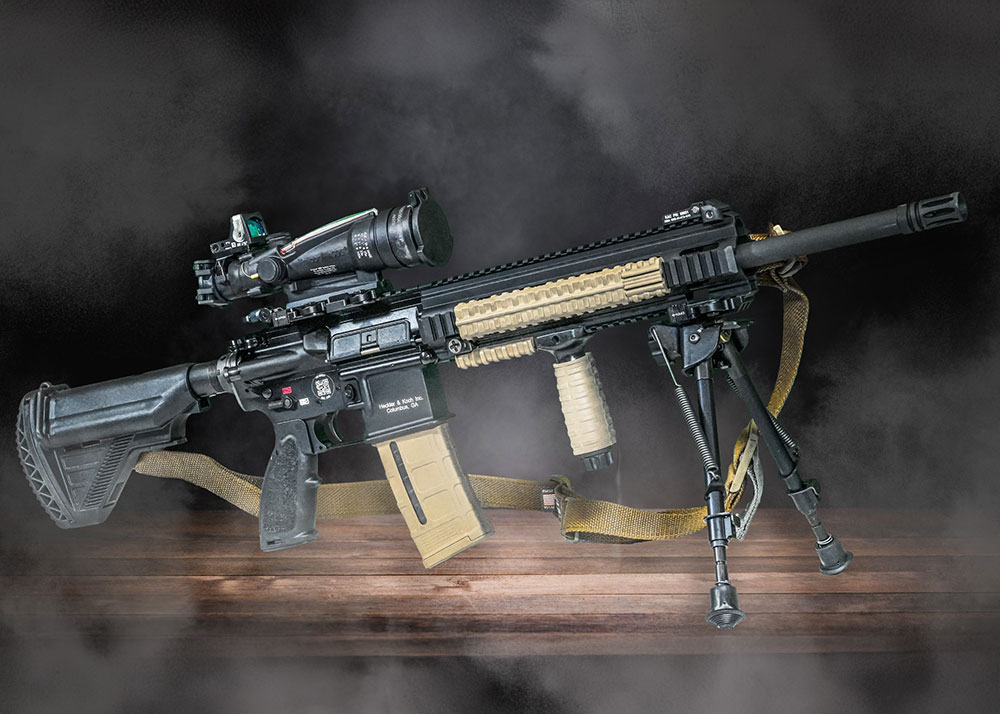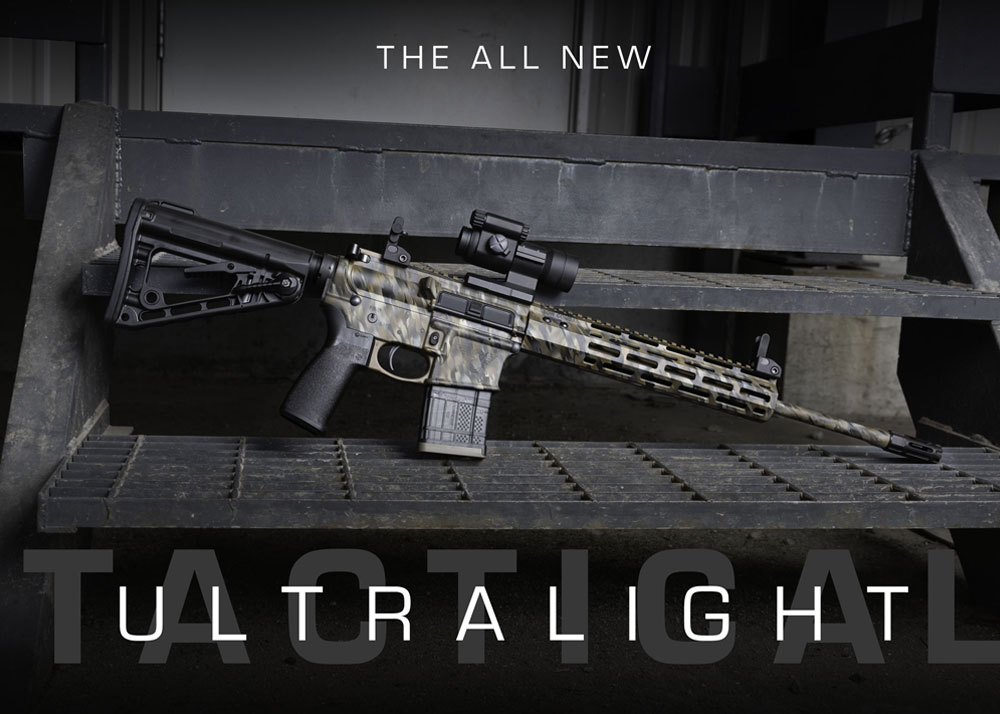Tokyo Marui MAC-10 AEP vs. KWC Mini UZI GBB
OptimusPrime
10 Dec 2007
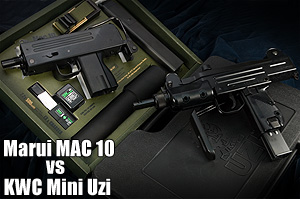
Now, the latest Feature review, courtesy of RedWolf Airsoft. This is a treat as they feature two of the hottests SMG replicas in the airsoft market, the TM MAC-10 AEP (Automatic Electric Pistol) and the KWC Mini UZI GBB (Gas Blow Back). Which SMG wins in this review, it all depends on your location, preferences, and of course your overall maintenance concerns during the life of these magnificent sub-machine guns. Our thanks again to Kai Wong of RedWolf airsoft for allowing us to post this great article.

HISTORY OF THE MAC-10 AND MINI UZI
Beginning from the first world war, submachine guns were developed from the style of a shortened rifle to a class entirely of their own. The German MP40 is a fine example of an attempt to make a short SMG: The barrel was made short, because the pistol cartridge doesn't benefit from a long barrel anyways, and a folding stock was added. Still, you can see that the receiver is quite long. After the barrel could not be shortened any further, it was time to think of fitting the action into a shorter package. The idea of extending the bolt forward around the barrel emerged around the 40's, and was first introduced in the Czech Samopal (SMG) model 25 in 1948.
Having the bolt wrap around the barrel allows to reduce the length of the receiver while retaining the bolt weight (essential in a direct blowback weapon), and it also helped to control the feed of the cartridge to reduce jams, as opposed to the STEN, where the cartridge has a lot of free space around it when it is stripped from the magazine into the chamber.
Both the MAC-10 and the UZI (including all their variants) use a bolt that wraps around the barrel. Also the exterior is similar enough that the weapons are constantly confused in popular culture.
UZI
After its initial launch in the early 50's, the compact UZI submachine gun became so successful, that only a limited number of changes were made over the decades. It was adopted by numerous police and other armed forces around the world, for example by the German Bundeswehr under the designation MP2. Despite the compact size, it was still able to provide full scale performance of an SMG and fired a 9x19 mm cartridge, as opposed to some even smaller designs that fired the relatively weak .380 ACP or 7.65 mm short pistol cartridges. The UZI was notably used in 1981 by a secret service agent, to cover the evacuation of US President Reagan, when the latter was wounded in an attempted assassination.
Despite the huge success, there are always special operators who demand that the weapon is made even smaller, and so the Mini UZI and Micro UZI (and their numerous variants) were developed. These models hit the surface in the early 80's and 90's respectively, and have users around the world even today. The Mini and Micro versions were criticized for the difficult control, due to the high rate of fire and lowered overall weight.
MAC-10
The Mini UZI was certainly not the first full power SMG in such a small package. Back in the good ol' US, a firearms designer named Gordon Ingram had been working on a model, that would fire the American .45 ACP cartridge in a small package, and paid close attention to production costs and the number of parts. The simplicity was sought to improve reliability and facilitate easy servicing of the weapon. The first developement stages began in 1964, and the first prototype was supplied to the US Army two years later.
The legend began when a suppressor company Sionics was incorporated into Military Armament Corporation (now you now what MAC stands for) in 1970, and a suppressor was developed specifically for the MAC-10. By that time the Army had complained of the wild behaviour of the MAC-10, and suggested a front strap to help keep the muzzle better in control. The suppressor added weight to gain stability, and reduced the muzzle blast and recoil to the point that the MAC-10 and the suppressor were thought of as a jar and the lid. Due to draconian restrictions on suppressors, exporting the weapon became difficult. A lot of large customers cancelled their orders, because the suppressor could not be included with the weapon. MAC went bankrupt in 1977, but the manufacture of the MAC-10 under various designations has continued nevertheless.

KIEN WELL and TOKYO MARUI
KWC is a fairly well known manufacturer of airsoft guns and other toys. Their products combine stable quality and good functioning with an affordable price. As a limiting factor they have no electric models in the line-up, but they have made some rather interesting gas operated rifles and submachine guns in the past with very simple gas systems, that borrowed some features from the classic "Bullet Valve" system, and had innovations made at KWC added to the mix. The more recent gas blowback pistols such as the P99 and 1911 series are more refined, as KWC have adopted a floating valve and other features from the reputable Western Arms Magna-Blowback into their pistols. The Mini UZI featured in this article features a floating valve actuated by a chambered BB, but the loading nozzle acts as a cylinder (rather than a Magna style piston), as found on the acclaimed Tokyo Marui GBB lineup.
The Mini UZI is supplied in a hard plastic case, very much like a box where you'd expect to find a drill or other tools. There's a large IMI logo on the side with the text "UZI", so you might want to carry this case in a bag, or at least with the logo against your thigh when going to a game to avoid unnecessary attention.
---
These days every man and their dog knows where TOKYO MARUI stand in the airsoft industry, but it wasn't like that always. In the past 15 years, Tokyo Marui has grabbed the markets of long arms (for which they developed the AEG gearbox), refined their gas blowback system (by sub-contracting the design to Tanio Kobayashi) to dominate the pistol market, and also released a spring operated sniper rifle. While competition has arised in those areas in the form of clones, the Tokyo Marui freight train just wouldn't stop and has pushed the development further. Starting with the G18C and MP7 AEP models, they proved that a worthy electric mechanism can be built into that size as well. A similar heart beats within the MAC-10. Maybe beating is the wrong sound to describe the sound of an AEP; After playing against these guns in the field, you might start to duck and cover in the street as well, when you hear the similar sound of someone unlocking their car.
The Tokyo Marui MAC-10 is supplied in a green cardboard box, with recessed parts in cardboard-covered styrofoam on the inside to hold everything in place and protect the AEP and accessories from knocks and bumps. It is supplied with a lot of accessories, as usual with the Tokyo Marui AEP series. Inside the box you'll find:
- Tokyo Marui MAC-10 AEP
- 65 round magazine
- Suppressor with foam inside
- OD support hand strap
- Loading and cleaning rods
- 7.2 V 500 mAh battery
- 110 V charger
- Outer barrel / suppressor disassembly tool
- Instruction manual with the important parts in English

LOAD AND MAKE READY
Setting the MAC-10 up for shooting is as simple as it is with any electric gun. The supplied charger only fits the Japan/US 110 voltage system, so players from other countries need a step-down adaptor as well. Connecting the battery to the charger is fool-proof as usual, because the battery refuses to connect any other than the right way. Charging the battery from empty to full charge takes roughly 2 hours, and the battery becomes slightly warm before reaching full charge. Should the battery or charger become alarmingly hot (clearly above body temperature) at any point, they should be disconnected immediately and checked for damage.
Inserting the battery into the MAC-10 requires some attention, as you have to set the safety button to "SAFE" position before you can open the battery compartment. With the safety on, you simply press the large front disassembly pin to the right until the outer barrel and front block of the AEP jump forward a bit. As with the charger, the battery will not lock into the AEP the wrong way around. The battery well features a pull tab for easy removal of the battery.
The magazines hold 65 rounds, and a larger 480 round hicap-magazine is available separately. The magazines feature a metal exterior to add a realistic feel and look to them. The standard magazine features an extended follower, which means it feeds every single BB in the magazine. (A feature we'd like to see more often in AEG magazines!) It has a weird spring-loaded part in the rear, which raised some discussion before the release of this model. It was speculated whether the MAC-10 would stop firing with an empty magazine, but this is not the case: Marui simply wanted to make the magazine look "complete" when it is removed from the gun, but the gearbox protrudes into the magazine well, so a step had to be made to allow the magazine to be inserted. The spring-loaded part tucks away into the magazine as you insert the magazine.

SETTING UP THE GAS GUN
If the Marui MAC-10 was easy to prepare for shooting, the same applies to the KWC Mini UZI as well. Out of the box, the Mini UZI uses standard Crosman/Gamo/Daisy type 12 gram CO2 capsules, which are readily available worldwide in sporting goods stores and supermarkets. The capsule is inserted into the magazine, and is held in place by a threaded cap, which is tightened using either a metric or imperial hex key. To hide it from curious looks, the cap is slightly recessed in the magazine.
Alternatively, you can replace the cap with an adapter, featuring a fill valve for regular airsoft propellants. This effectively converts the magazine for HFC134a and Green Gas use, and also lowers the velocity to a more user-friendly level. Our test unit chronoed 330 fps on Green Gas and 280 fps on HFC134a, using 0.2 gram BBs. With lower powered gases it may be advisable to replace the buffer spring with a slightly weaker one, as it is normally designed for the harder bolt movement from using high pressure CO2.
The all metal magazine loads just like any GBB magazine. You can use the supplied loading tube and rod to load 38 BBs into the magazine with one push, or manually pull down the follower and drop them in one by one, or with a BB loader. The magazine holds the BBs in two columns just like the real thing, and stops the bolt from cycling when the magazine runs out of BBs. (Whereas the real Mini UZI stops with the bolt forward and decocked.) After inserting a fresh magazine, you have to rack the charging handle once to chamber a round, just as if you were using a real one!
The Mini UZI features a very unique hop-up adjustment feature. It is easily accessible, yet ingeniously hidden! Tightening the barrel nut makes the outer barrel move back as well, and increases the hop-up via a transfer bar. The movement is so slight that you can't spot it with the naked eye, so the hop-up adjustment is perfectly hidden to add the realistic appearance. The realistic ratchet lock of the barrel nut keeps the adjustment positively in place, and makes the adjustment accurate thanks to the minute clicks.

CLOSER LOOK AT THE MAC-10
Being used to the small .380 M11-variants produced by Maruzen, Western Arms, KSC and HFC, the .45 MAC-10 really struck as a big and bulky gun when we opened the box. As opposed to earlier announcements, the grip and receiver of the AEP are ABS plastic, instead of metal. The surface is made quite well to mimic the sand-blasted and phosphate blackened real MAC-10, and together with the numerous metal detail parts the Marui MAC-10 actually looks convincing.
Lifting up the MAC-10 was a slight disappointment, as the big bulky box of a gun has a relatively low weight. At 1400 grams, it's not a light weapon to use single handed, and most pistols weigh only half of that. But compared to the hefty 2850 grams of the real MAC-10 or even the 1700 grams of a full metal GBB M11, the MAC-10 stands light in comparison.
One of the most acclaimed features of the Tokyo Marui AEP series is the ability to provide a very satisfying range, despite the relatively low muzzle energy. This is largely due to the excellent hop-up system, as it gives the BBs a very consistent spin and seals well to make the weapon efficient. The adjustment is performed by pulling back the bolt and turning the dial found inside the ejection port. The dial is actually quite large to facilitate small adjustments and make finding "the sweet spot" easy.
When it comes to the size, the MAC-10 is a bit deceiving. As said, it is huge compared to its smaller brother M11, but compared with an MP5 (G&G shown in picture), it appears rather small for an SMG. Then again when you add the suppressor and extend the stock, it's suddenly large again.
The suppressor included with the MAC-10 replicates the special two stage model, which was commonly bundled with the real one as well, as it made the weapon quiet and far easier to control. The Marui version is plastic and constructed from two halves, which renders it impossible to use on a real firearm, a point that may be helpful for players in countries where actual suppressors are restricted items. It features foam baffles to eliminate the muzzle pop, but can also house a Tracer Adapter for shooting tracer BBs.

DETAILS OF THE MINI UZI
The good looks of the KWC Mini UZI go deeper than the excellent carrying case. While the grip and receiver are ABS on the outside, the receiver has a full metal endoskeleton to make the weapon heavy (2.1 kg) and rigid. The metal parts are more numerous than just small details: The outer barrel and barrel nut are both metal, as is the folding stock (which attaches to a metal hinge directly on the metal frame), and the top cover, charging handle and dust cover. The magazine, bolt and all small details (sights, trigger, magazine catch...) are all metal.
Below the receiver in the rear a disclaimer text is found, but it's not easily visible. It does contain important bits of things to remember, such as never pointing the barrel at a direction where you wouldn't want to shoot, and keeping the finger off the trigger until the moment you want the weapon to fire. Naturally these safety precautions should be followed at all times, even if you just put the safety on or unloaded the weapon. There are no exceptions.
The left side of the receiver features the model and caliber markings, and a unique serial number. All markings are sharp and made neatly. The selector switch has settings for Safe, Repetitive and Automatic. The function follows the "rule" of firearms design, where "safe" is in the rear and the primary fire mode in front. If you wish to fire off single shots, you are expected to have time to set the selector in the middle position. The selector is stiff and tactile, very much like on a real firearm, as opposed to the less convincing control levers of various airsoft models.
The stamped steel dust cover below the cocking handle features a warning text, that is in fact found on the real Mini UZI as well. There are variants that shoot from the open or closed bolt, as well as semi and select fire versions, and trying to modify one model into another configuration is indeed unsafe and illegal. (The KWC variant fires from a closed bolt and shoots semi and full auto.)

BACK TO THE MAC
Just like on its rival in this review, the Tokyo Marui MAC-10 has a sturdy metal stock. Instead of a folding design, it is telescopic and only the part that rests against the shoulder has a hinge for folding. Deploying this stock type is slower than the lockless folding stock, but on the other hand it can be easily removed from the weapon entirely without tools. The hinge and lock system seems more rigid than the more delicate pins found on the airsoft M11 models, although we haven't heard of problems with those stocks either. The Marui stock has a superb detailing down to the weld marks, and provides a satisfying *CLICK* when you extend it.
The metal cocking handle serves no other purpose than to retract the bolt to access the hop-up adjustment dial, but it does have one additional feature: Turning it 90 degrees clockwise locks it in position, and blocks the sight picture as well. On the real MAC-10 the ability to lock the bolt forward is an important safety feature: The weapon fires from an open bolt, so if it was carried decocked with a magazine attached, a knock from dropping the weapon could retract the bolt far enough to strip a round from the magazine, but not quite far enough to get caught by the sear. Bang! It should be noted that turning the cocking handle does NOT prevent the AEP from firing, so the feature is purely an ornamental one for the sake of realism.
Instead of a combined selector/safety lever, Ingram designed the weapon with separate selector and safety controls, much like the M1A1 Thompson, or the FA-MAS and L85 assault rifles. The user may "pre-set" the weapon to the preferred fire mode, and simply flick off a single action safety before opening fire. While this prevents hassle with three (or four) positions of combined safety/selector controls, there's the chance that the user forgets which fire mode was selected. As a positive surprise, Marui has made the MAC-10 selector rather tactile to use.

MINI UZI TO THE BONE
The Mini UZI features improved sights over its predecessor, and they are actually quite good for SMG sights. The front sight is adjustable for elevation, and the rear sight has two aperture presets for range, and the windage adjustment. Sounds familiar? Well it's just like on the M16.
A takedown button is located in front of the rear sight. Pressing the button allows to lift the top cover off, revealing the massive metal bolt and the recoil spring assembly. Pulling the bolt back a bit allows you to lift up the front, and pull everything out forward at an angle. You now have full access to each and every part you need to clean and lubricate in order to keep the Mini UZI running. The disassembly procedure is exactly the same as on the real Mini UZI, which means you don't need tools and it's simple to do even with a blindfold on.
---
Taking the basic field strip further into details isn't as hard as you'd think. For example the blowback assembly comes apart without any tools, and there are no small parts or pins to lose. KWC has omitted the spring from the floating valve entirely, because the position is controlled by the BB, and it is closed by the gas flow when the BB is shot. It doesn't even have a retainer of any kind, because it is supported in the rear by the piston head. The loading nozzle comes off simply by pulling it at a slight angle, and you can then shake the floating valve out from the rear of the nozzle. The piston head is an improved model to get a better efficiency and kick, but it can also be replaced by upgrade piston heads with a thick enough O-ring.
After unscrewing the barrel nut and removing its retainer, you can use the front sling mount as a pin to drive out the grip pin. The Mini UZI is now completely disassembled, and the amount of tools required was again a round zero. Do click on the detail strip picture for all the components and their names!

The firing system of the Mini UZI is rather interesting, because it's a closed bolt variant. This system was developed for demanding users, who felt that the "lock time" (time from pulling the trigger to the bullet leaving the barrel) was too long with an open bolt weapon, such as the original UZI. An open bolt design would also nudge a bit right before firing, which isn't exactly a desired feature when you want to place a precise shot.
The trigger is linked to a similar sear system as with an open bolt, but the bolt is split into a separate bolt and "striker", which is actually a linear hammer. When the weapon is cocked, the sear only catches the linear hammer, and the bolt returns forward chambering a round from the magazine.
When the trigger is pulled, the linear hammer knocks the valve open (ignites the primer on the real one) via a firing pin, and the blowback action pushes both the linear hammer and bolt back to the rear, where the former is caught again and the bolt returns forward. If the selector is on Auto, the bolt trips an auto sear as it goes into battery, releasing the linear hammer for another shot.

CAN YOU DO THAT WITH A MAC?
The Marui MAC-10 doesn't strip quite that far without tools. Actually apart from changing the battery, you will need at least an allen key for any disassembly, for example to change the fuse. There wouldn't be much to see on the inside anyways, because the receiver houses an enclosed gearbox unit. The beauty of an AEP lies in the fact that you never need to disassemble it for regular maintenance. Simply keeping the barrel and hop-up clean is enough to keep an electric gun running for five-figure numbers easily, and we're not just saying it'll reach only 10k.
As a nice feature, the outer barrel of the MAC-10 is double-threaded. It has a large thread for the included foam-filled suppressor unit, but unscrewing the muzzle (with a tool that engages the mock rifling!) reveals a standard left-hand 14 mm thread, so you can attach a suppressor or flash hider of your choice. The tool doubles as a disassembly tool for the suppressor, in case you want to replace the foam baffles with a tracer unit for a cool tracer effect in the dark!

WELL WHICH ONE IS IT THEN?
Making a choice between the KWC Mini UZI and the Tokyo Marui MAC-10 is not hard, if you already like one model better than the other. But if you're like Chuck Norris and are comfortable with either (or one in both hands), you should look at the things that set the models apart deeper than the surface.
A gas gun undoubtedly is more fun to shoot, provides a menacing sound and a more realistic action. In this case the gas model is also clearly more powerful and realistic when it comes to the weight. With some models (like the Marui vs. Maruzen Scorpion) the difference in power is smaller, and the Scorpion AEP is actually the more refined when it comes to the finishing. But in terms of "feel" the KWC Mini UZI wins this round hands down.
What people in cooler countries can appreciate in an AEP, is the fact that it provides a stable performance even if the temperature has dropped a few degrees, and keeps working even when you go below zero, while gas guns start venting and the performance becomes very poor. Even though the Mini UZI has CO2 capability, it is not invulnerable to the cold, and we would recommend the MAC-10 AEP as the better option if you want to play around the year. Switching between two batteries with one close to your body is likely to keep the MAC-10 running in any conditions where you would dare to play.
You could think of the AEP as a scooter that takes you to work or the mall every day, and won't let you down when you need it. But when you see that Harley Davidson of a Mini UZI in the rear view mirror, you better make way.

